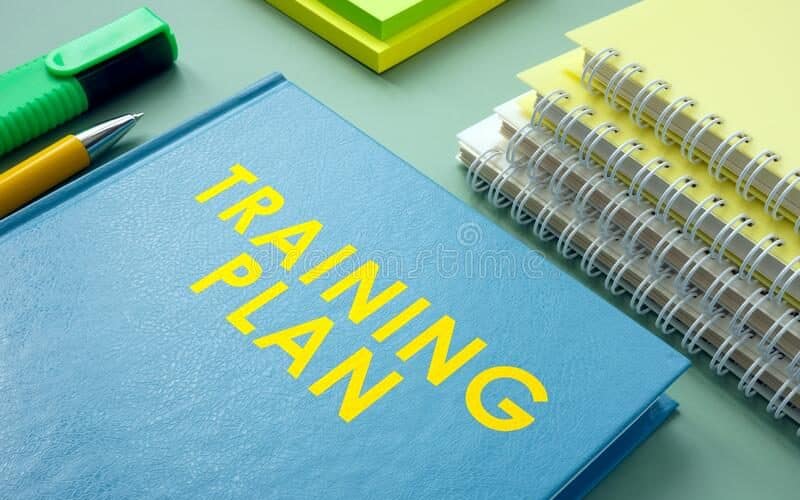Employees are a crucial part of any successful enterprise. With the proper resources at their disposal, your company is sure to thrive. In order to make sure that your employees know what to do and how to do it, it’s important to have a solid training plan in place. Furthermore, continuing education is something that many employees appear to cherish, and a training plan has the potential to be an enormously effective and useful resource. According to research, “90% of employees would stay with a company longer if there was an investment in learning.” An Employee effective training plan, and by extension, learning and development divisions, are powerful tools for recruiting and retraining employees. How to create a training plan for employees and good practice training plans examples will be discussed in this article.
What is Training Plan?
A training plan is a list of the methods and materials that will be used to teach employees how to do their jobs well. A more involved strategy could include a hands-on activity or a series of questions for employees to think about, or it could be as straightforward as a quick overview. However, a good training plan will outline all the skills and knowledge that employee needs to have in order to do their job effectively. The need for a training plan is underscored by the fact that a variety of unexpected circumstances can arise during any one lesson.
Furthermore, the training plan shouldn’t entail a new worker stepping in and you dropping everything on their desk. If you want your training efforts to pay off, you need to make sure your employees know exactly what they need to know when they need to know it, and for how long they need to consume the training content before they can start making a positive impact on the firm.
An efficient training procedure that results in a productive staff quickly requires a well-thought-out training plan. Employee productivity can be increased and the employee’s value to the firm can be maintained by providing them with quality training early in their employment.
Nevertheless, when these plans are not clearly defined and managed, progress toward objectives is slowed or halted, employees receive conflicting messages, and time is wasted.
What Are the 4 Types of Training?
Training is a deliberate experience that is aimed to change one’s attitude and actions. An effective training plan provides employees with the information, skills, and attitudes they need to perform their primary duties to their fullest ability.
The training prepares the worker for the rigors of the job by acquainting him with the necessary skills and actual workplace settings. Effective training comprises acquiring the knowledge and competence to perform a task through instruction, drill, and discipline.
Furthermore, training is one of the cornerstone concepts in HRD. The process involves instructing and training a person to do a skill to a high level. Training is a highly effective method of empowering individuals to carry out their responsibilities competently, ethically, and effectively. Additionally, training refers to the act of imparting specific information and abilities to an individual.
Organizational growth, productivity, and the ability to hold onto key employees are all aided by investing in their employee’s professional growth. Human resources seek to support this goal by providing opportunities for professional growth. If companies avoid addressing these issues, the staff development process will be inefficient, frustrating, and wasteful of everyone’s time. Here are the 4 types of training.
#1. Beginner’s Training
Keeping up with the latest innovations in technology requires technical employees to take part in quick training courses designed to update their skills and knowledge in order to meet the demands of the modern workplace. Staff members may be urged to attend workshops, seminars, and other forms of continuing education in order to maintain marketability. In today’s ever-evolving world, changes are constant not just in technology but also in tactics and policies. Work as we know it today may become irrelevant in the near future.
With Refresher Training, employees are reminded of their previous training but are shown new and improved methods to help them maintain a competitive edge. Short courses are required so that they may stay abreast of developments in their field and confidently tackle any challenges that may arise in the future.
#2. Promotional Training
Existing employees receive this training so that they may perform more senior roles in the business. Those employees who have the potential to rise up the ranks and take on greater responsibility are selected for those roles. Also, they receive training in areas that may become more important to them in the event of a promotion. They can be sent to schools for the purpose of obtaining vocational training.
#3. Job/Professional Training
Employees are urged to take advantage of this chance to increase their competence in their specialty areas. When the abilities needed to complete a task and the capabilities of the workforce are incompatible, training is essential. Management will typically assign senior employees, supervisors, or designated instructors to give on-the-job training (On Job Training).
To achieve the goals, a training program and plan are designed, and materials are created. Instructional methods such as lectures, individual coaching, and specialized classes are evaluated and selected. Abilities in reading, writing, communicating, interacting with others, and so on are all instances of fundamental skills. Also, read PROFESSIONAL DEVELOPMENT: Things You Need to Know.
#4. Soft Skills Training
Soft skills training is the fourth area we cover. Personality characteristics, social graces, communication, and routines are all examples of soft skills that help define how one interacts with others. Among these “soft skills,” telephone etiquette and customer service courtesy are two examples. Sexual harassment prevention and ethics education programs are two possibilities. Motivating others, keeping up casual conversations, and forming connections with people are all examples of soft skills that can prove useful in the workplace.
Furthermore, in the service industries, such as retail and hospitality, soft skills are essential for delivering a positive client experience at every point of contact. In fact, a survey conducted by Computerworld magazine found that executives believe there is a growing demand for employees with not just the requisite hard skills but also the requisite soft skills, such as excellent listening and communication skills, to accomplish the job effectively.
All successful companies recognize the value of investing in their employee’s professional growth. Training programs like these help workers improve their skills, productivity, and prospects for advancement. An organization’s human resources are only as strong as the skills, knowledge, and attitudes of its workers. Nevertheless, the impact of these essentials is sometimes dampened due to a lack of sufficient training programs. Human capital is a company’s most valuable asset, and it may be developed to its full potential through training and education. Building up the skills of the people who work for an organization can also help it achieve greater success. The consequence is a flatter organizational structure with fewer people between the top and bottom.
Training Plan for Employees
The goal of every company’s training plan for employees is to help them do a better job in their current jobs or prepare them for promotions or new jobs within the company. A company’s training program could be part of a larger L&D strategy, which is an effort to improve the performance of an employee or the organization as a whole, or even to create a more positive and productive culture at work.
Here are simple steps to create an effective training plan for your employees:
#1. Compose a Training Plan
This is an easy step to create an effective training plan for employees. By writing out the steps in such great detail, you make it impossible for anyone to get confused.
Instructions, safety procedures (if needed), and other materials should be spelled out in detail, and the training should be clear about who it is for. It is intended that the training would feel natural, uncomplicated, and easy to follow.
At this point, you should begin planning the training programs and educational paths that will help your staff members acquire the necessary expertise. If you’re having trouble developing a plan for training employees, it may be helpful to look at resources specifically designed to facilitate this process.
#2. Recognize Your Target Demographic
Evaluate your employees before coming up with a training plan. In-depth training on the company’s mission, resources, and individual particular aims may be necessary for new hires. In the meanwhile, a training needs analysis can be necessary for new hires or interns moving into permanent employment. In this step, you’ll compare the knowledge and abilities of your employees to the requirements for the position. The type of training plan developed depends on the accuracy of their evaluation. Create a strategy that takes into account the learner’s current level of expertise and future goals.
#3. Analyze the Training Needs and Make Ensure Everything Aligns
The first step in developing a workplace training program is to conduct a needs analysis and identification (Training Needs Assessment). It’s used to figure out what employees should know, do, and be able to do better after the training is over. If you’re starting from scratch and designing a training plan, it’s important to determine what you should concentrate on.
The creation of a training plan template is not complete without a part dedicated to the establishment of objectives and the monitoring of relevant metrics and key performance indicators. This component of a training program is vital as it facilitates the process of establishing measurable training results. When there are well-defined objectives and methods for achieving them, the overall picture becomes much clearer.
While developing a strategy, it’s important to consider both the needs of the company and those of its employees. In other words, before beginning any training program, you should determine what resources your organization needs. If workers are more invested in the training process because they understand its value, it helps to communicate that value to them early on.
#4. Determine What You Want to Get Out of This Training
Setting learning objectives is the next step after determining who your training plan is for and what kind of training is needed. In preparation for a training session, you must establish the goals you hope the trainees will achieve. In order for the training to be successful, its goals must be focused on specific knowledge or abilities acquired by the learners. If you don’t want to overburden your trainees or yourself, stick to a single or a maximum of two goals per session. In addition, keeping just one or two goals in mind will help you focus while exercising.
#5. Set the Pace of Your Training
According to research, about 70% of workers today lack the proficiency to do their tasks properly. So, it is necessary to provide re-training for employees who are falling behind or having difficulty doing their day-to-day duties in order to keep them proactive and interested.
Determine how often training should be provided and when it would benefit employees the most. Consider including monthly training in your workplace training strategy if, for instance, you regularly hire several new employees in a single month.
Choose the educational opportunities that will help your staff achieve their goals while also advancing the company’s mission. Training should come in a variety of forms to give workers a say in how they learn.
#6. Establish Unity Amongst Leaders
The first step in achieving leadership engagement is communicating the organization’s goals and the anticipated results of the training. Leadership needs to make their approval of this clear for this to have any impact. Without leadership commitment and alignment, even the most well-laid training initiatives can fail.
Create a training plan template that will entice employees to study. Put together an engaging training plan by crafting a clever hook for your company. In general, adding some lighter components to your workplace training plan template is a great way to keep your employees interested.
Leaders should listen to their followers and be willing to adjust the plan as needed. Learners can provide and receive feedback at any point in the course with the help of integrated feedback. This method can improve training by increasing learner involvement and employee agency, as well as by providing useful insights.
#7. Execute Your Plan
It’s important to consider both the employees’ current training levels and their preferred learning methods as you develop the program. Before implementing a training plan company-wide, many businesses undertake test runs and solicit feedback from employees.
At this point, you’ll put your plan for training employees into action. Adjustments to the actual implementation may be necessary throughout training. Similar to how some workers may finish training sooner than expected, others may take longer. Because of this, you’ll have to make adjustments to the training program to accommodate their requirements.
Examples of Training Plans for Employees
Plans for training employees are crucial for the success of any company in the modern era. Training programs, whether in-person or digital, are essential for any business. They do a great job of keeping staff interested and up-to-date on technological developments.
In addition to making employees feel appreciated, these training plans improve their competence and prepare them for future roles. Corporate training programs help new employees adjust to their new roles and feel good about the results they produce.
Many worry about the cost of training, so they put it off. Such concerns disappear, however, if you put in the effort upfront. Having a solid framework for training employees is essential, but so is the creation of training materials, plans, and examples. Most businesses have people on staff with college degrees in relevant fields who are able to instruct new hires. Others, however, prefer to bring in trainers from the outside due to their superior knowledge. Here are some examples of training plans for employees.
Efficient Management Training
The goal of this training is to help mid-level managers develop the leadership abilities necessary for advancement to senior management positions.
- Find out what it takes to lead a company.
- Discuss methods of becoming a brilliant leader in your group of peers.
- Build rapport with your team by practicing these strategies together.
- Improve your social and emotional abilities and your ability to listen attentively.
Method of distribution: Live and on-demand webinars.
Methods of judgment: Conduct a team-building activity for your workplace.
Half-Marathon Training Plan
A half marathon consists of running 13.1 miles, which is well within the capabilities of most runners.
It’s simpler to fit the training into a hectic life than it is for a marathon, says British athlete and RW contributing editor Jo Pavey, so it’s a challenge that can be met. But it’s still a large jump for individuals who aren’t used to running that far, and you’ll need to increase your weekly mileage, go on longer long runs, and do more varied training to build the necessary endurance and speed. We have everything you need to cross the finish line in style.
Why Should I Follow a Half-Marathon Training Plan?
According to a running coach, if you have the appropriate plan, you can better train the various parts of your performance that will come together on race day. Following a well-thought-out schedule will help you get in all the training you want to do during the week without increasing your risk of injury or overtraining.
Keep in mind that success is never an overnight occurrence but rather the result of persistent effort over time. Resist the need to go overboard on your workouts; each session is planned out with the complete training schedule in mind, not just what you need to do for the day. You won’t give your body a chance to recover from the high-quality training you’ve been doing, for instance, if you push too hard during an easy run.
What Must Be Included in a Training Plan?
When creating a training plan, it’s important to first conduct a training needs assessment to determine the specific knowledge and abilities each employee is missing. There needs to be a section on learning outcomes that specifies what employees should know after completing the course. It should also detail the resources and delivery strategies that will be utilized throughout the training process. Any worthwhile training plan also has to incorporate metrics for measuring achievement. The flexible and user-friendly format of monday.com’s achievement tracking template makes keeping tabs on your progress a breeze.
Conclusion
One of the most important things you can do for a project is to plan, design, develop, and execute a training strategy that equips the people who will be supporting it with the knowledge, abilities, and behaviors they’ll need to succeed in their new jobs or in the future state.
A company’s business processes, technology, or systems may undergo a change, necessitating the addition of a new employee to the staff or the assignment of new responsibilities to current workers as a result of a reorganization or other factors.
External parties (such as customers, suppliers, vendors, distributors, consulting partners, etc.) may also need to be trained as part of a company’s training plan, especially if the company has recently implemented new business processes, sales programs, re-engineered ways of conducting transactions, or any other changes that may affect how they interact with the company.
Training planning strategies frequently remain the same whether you’re imparting knowledge to fresh recruits, seasoned workers, middle managers, top brass, or outsiders. Your training plan, which must be adapted for each of your intended trainees, is the only variable.
Training Plan FAQs
What are the four 4 steps of preparing a training plan?
- Competency Deficiency Assessment. Prior to beginning, it is important to pinpoint problem areas.
- Describe your goals and your approach.
- Fund the Appropriate Means of Production.
- Do some testing, take some notes, and then do it again.
What is a training plan template?
Using this Training Plan Template, you and your team can organize your thoughts and create a comprehensive training plan. The rationale, essential elements, knowledge, skills, outcomes, and evaluation can all be discussed with this resource as a reference.
Similar Posts
- FEDERAL LAWS THAT PROTECT EMPLOYEES: Why Your Boss Cant Mistreat You
- BEST ONLINE MANAGEMENT COURSES: Best Online Courses
- The Top Must-Have TECHNICAL SKILLS FOR RESUME With Examples
- DIVERSITY TRAINING: Definition, Types, Examples and Strategies






